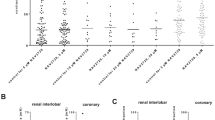Summary
Recently, Kaumann and Frenken (1985) proposed an allosteric model of vascular 5-HT2-receptors. We now present experiments in both bovine coronary and pulmonary artery, using the method of irreversible receptor occlusion, that support and extend the model. 1 Phenoxybenzamine was found to cause irreversible antagonism of the effects of 5-hydroxytryptamine (5-HT). Maximal contractile effects induced by 5-HT were depressed and, with further receptor occlusion, concentration-effect curves for 5-HT became biphasic. The high-sensitivity and the low-sensitivity component of the curve for 5-HT consisted of quickly and slowly developing contractions, respectively. 2 Biphasic concentration-effect curves for 5-HT after receptor occlusion were shifted to the right in non-parallel manner by ketanserin and became monophasic with an unexpected partial restoration of maximal responses to 5-HT. The magnitude of the shift of the partially restored concentration-effect curve for 5-HT by ketanserin after receptor occlusion by phenoxybenzamine is consistent with an interaction of ketanserin with 5-HT2-receptors. 3 Preincubation with methysergide before phenoxybenzamine-treatment followed by washout of both drugs, and subsequent incubation with ketanserin completely prevented a depression of 5-HT-induced effects by phenoxybenzamine. 4 Estimates for the equilibrium dissociation constant of 5-HT for the 5-HT2-receptor derived from fast developing contractions range from 0.1 μmol/l to 0.4 μmol/l. 5 The results are consistent with a model of two interconvertible states of the 5-HT2-receptor. Phenoxybenzamine occludes the 5-HT2-receptor in the R-state but not in the R′-state. The low active R′-state of the 5-HT2-receptor appears to pre-exist in the absence of drugs and is not affected by phenoxybenzamine. By converting R′ into R ketanserin restores partially the response to 5-HT after occlusion of the R-state by phenoxybenzamine. Methysergide prevents the 5-HT2-receptor occlusion induced by phenoxybenzamine indirectly by favouring isomerisation into the R′-state.
Similar content being viewed by others
References
Blinks JR (1965) Convenient apparatus for recording contractions of isolated muscle. J Appl Physiol 20:755–757
Clancy BM, Maayani S (1985) 5-Hydroxytryptamine receptor in isolated rabbit aorta: characterization with tryptamine analogs. J Pharmacol Exp Ther 233:761–769
Frenken M, Kaumann AJ (1984a) Interaction of ketanserin and its metabolite ketanserinol with 5-HT2-receptors in pulmonary and coronary arteries of calf. Naunyn-Schmiedeberg's Arch Pharmacol 326:334–339
Frenken M, Kaumann AJ (1984b) Interconversion between two 5-HT2-receptor states in large coronary artery (CA) of calf. Proceedings of the 9th International Congress of Pharmacology, London, UK, MacMillan Press Ltd, p 170P
Frenken M, Kaumann AJ (1985) Tryptamine interacts with both the 5-HT2-receptor and an allosteric site in bovine large coronary artery. Pflügers Arch 403:R32
Frenken M, Kaumann AJ (1987) Allosteric properties of the 5-HT2-receptor system of the rat tail artery. Ritanserin and methysergide are not competitive 5-HT2-receptor antagonists but allosteric modulators. Naunyn-Schmiedeberg's Arch Pharmacol 335:359–366
Furchgott RF (1954) Dibenamine blockade in strips of rabbit aorta and its use in differentiating receptors. J Pharmacol Exp Ther 111:265–284
Furchgott RF (1966) The use of β-haloalkylamines in the differentiation of receptors and in the determination of dissociation constants of receptor-agonist complexes. In: Harper NJ, Simmonds AB (eds) Advances in drug research. Academic Press, London, pp 21–25
Furchgott RF, Bursztyn P (1967) Comparison of dissociation constants and of relative efficacies of selected agonists acting on parasympathetic receptors. Ann NY Acad Sci 144:882–899
Kaumann AJ (1983) Yohimbine and rauwolscine inhibit 5-hydroxytryptamine-induced contraction of large coronary arteries of calf through blockade of 5-HT2-receptors. Naunyn-Schmiedeberg's Arch Pharmacol 323:149–154
Kaumann AJ, Frenken M (1985) A paradox: the 5-HT2-receptor antagonist ketanserin restores the 5-HT-induced contraction depressed by methysergide in large coronary arteries of calf. Allosteric regulation of 5-HT2-receptors. Naunyn-Schmiedeberg's Arch Pharmacol 328:295–300
Kaumann AJ, Breuer H-WM, Arnold G (1982) Heterogeneous spare receptors for serotonin (5-HT) in bovine coronary arteries. Pflügers Arch 392:R36
Kaumann AJ, Frenken M, Lemoine H (1985) Allosteric regulation of 5-HT2-receptors in smooth muscle. Naunyn-Schmiedeberg's Arch Pharmacol 330:R64
Leff P, Martin GR, Morse JM (1985) Application of the operational model of antagonism to establish conditions when functional antagonism may be used to estimate agonist dissociation constants. Br J Pharmacol 85:655–663
Lemoine H, Grauduszus, M, Mahmud M, Kaumann AJ (1982) A regional survey of muscarine receptors of human oesophagus and cardia. Pflügers Arch 392:R36
Leysen JE, Awouters F, Kennis L, Laduron PM, Vandenberg J, Janssen PAF (1981) Receptor binding profile of R 41468, a novel antagonist at 5-HT2-receptors. Life Sci 28:1015–1022
Leysen JE, Niemegeers CJE, van Nueten JM, Laduron PM (1982) [3H]Ketanserin (R 41468), a selective 3H-ligand for serotonin2 receptor binding sites. Binding properties, brain distribution and functional role. Mol Pharmacol 21:301–314
Morris TH, Sandrock K, Kaumann AJ (1981) 3H-(-)-Bupranolol, a new β-adrenoceptor radioligand: Characterization of its binding to kitten heart β-adrenoceptors. Naunyn-Schmiedeberg's Arch Pharmacol 317:19–25
Stephenson RP (1966) Measurements of affinity constants of partial agonist and agonist drugs. Proc 3rd Intern Congr Pharmacol, Sao Paulo, p 1
Van Nueten JM, Janssen PAJ, van Beek J, Xhonneux R, Verbeuren TJ, Vanhoutte PM (1981) Vascular effects of ketanserin (R 41468) a novel antagonist of 5-HT2 serotonergic receptors. J Pharmacol Exp Ther 218:217–230
Author information
Authors and Affiliations
Additional information
This work was supported by grant SFB 30 Kardiologie 04 of the Deutsche Forschungsgesellschaft
Rights and permissions
About this article
Cite this article
Frenken, M., Kaumann, A.J. Interconversion into a low active state protects vascular 5-HT2-receptors against irreversible antagonism by phenoxybenzamine. Naunyn-Schmiedeberg's Arch Pharmacol 335, 481–490 (1987). https://doi.org/10.1007/BF00169112
Received:
Accepted:
Issue Date:
DOI: https://doi.org/10.1007/BF00169112




